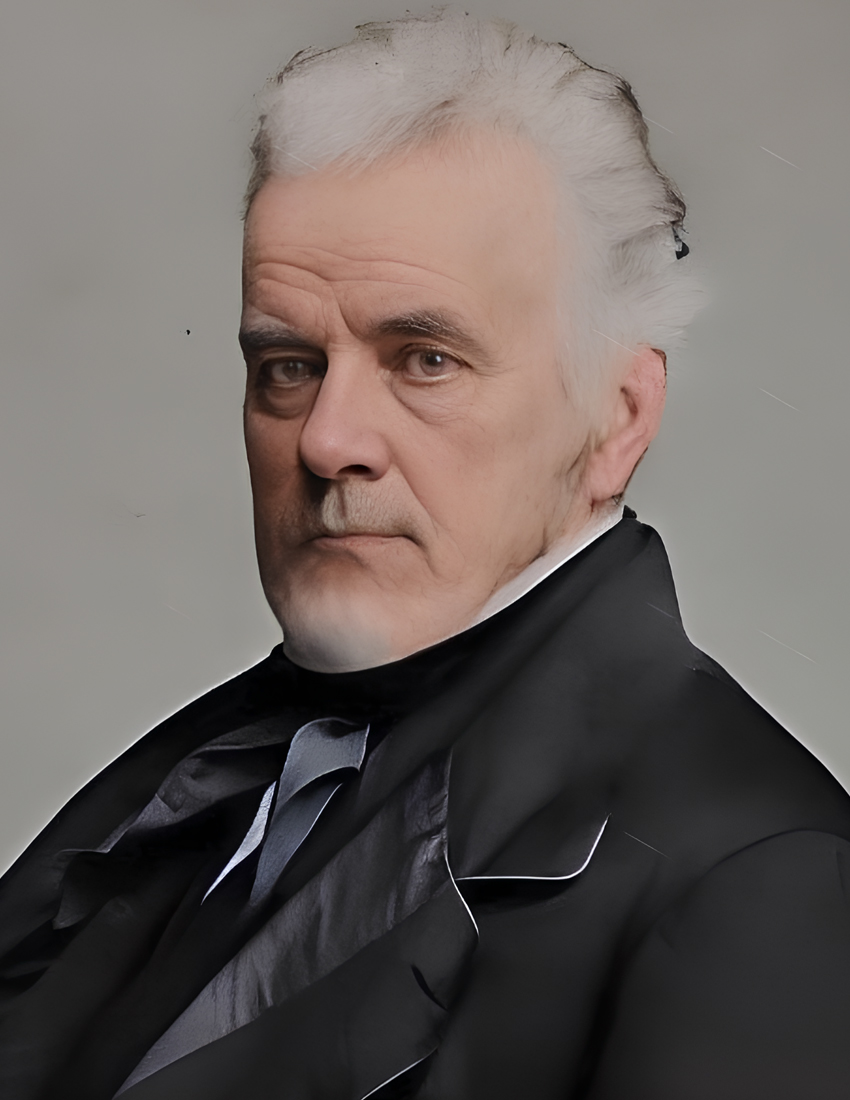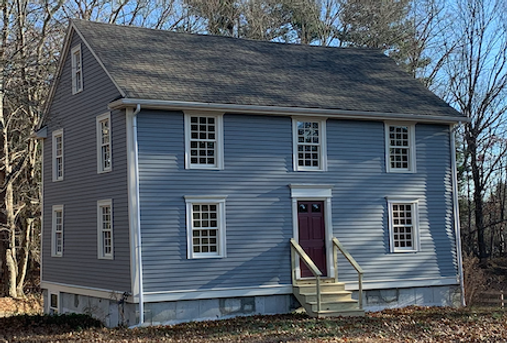Born: January 8, 1792, Medfield, MA.
Died: August 11, 1872, at his home, Silver Spring, in Orange, NJ.
Buried: Rosedale Cemetery, Montclair, NJ.
Lowell Mason

Hymns by Lowell Mason

The Lowell Mason House, birthplace of the “father of music education,” was rescued from demolition in 2011. Now relocated near Hinckley Pond in Medfield, MA, this 1792 structure is being transformed into a vibrant cultural center. It will honor Mason’s legacy, advocate for music education, and offer diverse musical experiences, preserving history while inspiring future generations.
The Father of American Music Education
The year was 1837, and the Hawes School in Boston buzzed with excitement. For the first time, music would be taught as part of the regular curriculum. At the front of the classroom stood Lowell Mason, a 45-year-old banker turned musician, ready to embark on an experiment that would change the face of American education forever.
This moment was the culmination of Mason’s lifelong passion for music, a journey that began in 1792 in the small town of Medfield, Massachusetts. Born into a musical family, Mason grew up surrounded by the melodies of church hymns and the resonant tones of his father’s bass viol. Both his parents sang in their church choir, immersing young Lowell in sacred music from his earliest days. Little did anyone know that this child would grow up to revolutionize not only how Americans sang in church, but how they learned music altogether.
From these humble beginnings, Mason would go on to compose over 1,600 hymns, pioneer music education in public schools, and leave a lasting impact on American sacred music. His story is one of innovation, perseverance, and the transformative power of music – a legacy that continues to shape our cultural landscape today.
A Musical Seed Takes Root
Young Lowell’s childhood was steeped in melody. Both his parents sang in the church choir, and his father’s bass viol often filled their home with rich, resonant tones. It was as if music coursed through his veins, a gift waiting to be cultivated and shared with the world.
At the age of 13, Mason received his first formal musical training. During his teenage years, he studied composition with Oliver Shaw and attended a singing school taught by Amos Albee, developing his natural talents under careful guidance. By the age of 16 Mason had already taken up the mantle of choir director at his local church. His natural talent and leadership were evident, even then. At 18, he became the music director at the Medfield Unitarian Universalist Church and directed the Medfield town band just two years later. But it was his move to Savannah, Georgia, at 20 years old, that would truly set the stage for his life’s grand performance.
In Savannah, Mason’s days were filled with the practical matters of banking and dry goods. Yet his nights and weekends belonged to music. He led singing schools, directed choirs, and even became the organist at the Independent Presbyterian Church. It was here, in this southern city, that Mason’s musical seed began to sprout and grow.
The Harmony of Faith and Music
Mason’s faith was the bedrock of his musical pursuits. As Sunday school superintendent at his church, he opened the first Sunday school for black children in America, a testament to his belief in the power of music and education to transcend societal boundaries.
During his time in Savannah, Mason took a wife, Abigail Adams, establishing roots in the southern city. He also served as Secretary of the Savannah Missionary Society, founded in 1818, demonstrating his commitment not just to music but to community service and his faith.
Under the tutelage of German-born Frederick L. Abel, Mason honed his composition skills. Abel had immigrated to Savannah in 1817 and quickly recognized Mason’s potential. Inspired by William Gardiner’s “Sacred Melodies,” he set about creating his own collection of hymns. Little did he know that this endeavor would be the overture to his life’s grand symphony.
In 1822, The Handel and Haydn Society of Boston published Mason’s collection, albeit anonymously at his request. As a successful banker in Savannah, Mason felt it prudent to keep his musical pursuits separate from his professional identity. The hymnal was an instant success, selling over 50,000 copies – an astounding feat for the time. It was as if the nation had been waiting for Mason’s melodies, thirsting for the pure, simple beauty of his arrangements.
Boston: A New Stage for a Growing Maestro
The success of his hymnal drew Mason back to Boston in 1826. Here, he would find his true calling, not just as a musician, but as an educator. He became the president and musical director of the Boston Handel and Haydn Society, breathing new life into the organization.
Within two years of his return to Massachusetts, Mason compiled and published The Juvenile Psalmist in 1829, believed to be the first collection of Sunday school music in America. He followed this success with The Juvenile Lyre in 1831, a collection of school music specifically for children, laying the groundwork for his educational philosophy.
But it was in 1833 that Mason would plant the seeds of his most enduring legacy. Together with George James Webb and Samuel A. Eliot, and with significant contribution from William Channing Woodbridge, he established the Boston Academy of Music. This institution would become the cradle of American music education, nurturing the talents of thousands of students and elevating the standards of church music.
The Academy proved immensely popular, enrolling over 3,000 students by its second year of operation. It offered both vocal and instrumental instruction, developed choral and instrumental ensembles, and gave public concerts, including the first American performances of Beethoven symphonies.
Mason’s vision was clear: music education should be for the masses, not just the talented few. He believed in the power of music to uplift, to inspire, to bring people closer to God. And so, he set about making this vision a reality.
In 1834, Mason published The Manual of the Boston Academy of Music, an edited translation of G.F. Kuebler’s Anleitung zum Gesang-Unterrichte in Schulen. This influential work, based on Pestalozzian principles, would guide music teachers for generations to come.
The Better Music Movement: A Double-Edged Sword
Mason’s efforts to improve American church music were not without controversy. He spearheaded what came to be known as the “Better Music Movement,” which sought to eliminate what he viewed as “crude and lewd” music in favor of more refined European classical styles.
This movement was guided by seven principles of music education that Mason espoused in his Manual. The final principle, “To have the names of the notes correspond to those used in instrumental music,” would profoundly impact American music history. Prior to Mason’s influence, American sacred music was characterized by the vibrant works of composers like William Billings, Daniel Reed, and Justin Morgan, who made free use of counterpoint and dance rhythms with looser harmonic rules than their European counterparts.
While his intentions were noble, this movement had the unintended consequence of suppressing the vibrant, uniquely American sacred music traditions that had flourished before his time. The robust, participatory style of composers like William Billings gave way to Mason’s more structured, European-influenced approach.
Many music historians and early music specialists have criticized Mason for this aspect of his legacy. Joel Cohen, a noted specialist in early American music, once remarked that Mason “spent his long career trying to ‘correct’ the vital American folkhymn tradition and to replace it with something blander, and worse.” The tradition that Mason largely succeeded in displacing retreated to the inland rural South, where it survived in forms such as Sacred Harp music, which has experienced a revival in recent decades.
This aspect of Mason’s legacy remains a point of debate among music historians. Some argue that he stifled a burgeoning American musical voice, while others maintain that he improved the overall quality of American sacred music.
The Dawn of Public School Music Education
Perhaps Mason’s most enduring legacy was his role in introducing music education to American public schools. In 1837, he volunteered to teach music at the Hawes School in Boston, marking the first time music was taught in a public school in America.
Interestingly, the basis for introducing music education had little to do with music’s aesthetic value. The Boston school board’s special committee recommended music based on three standards: intellectual, moral, and physical benefits—the latter referring to how singing would “expand the chest and thereby strengthen the lungs and vital organs.” No mention was made of musical standards or the importance of music in human experience.
The experiment was a resounding success. Mason’s methods, based on the principles of Swiss educator Johann Pestalozzi, emphasized active learning and participation. Children who had never been exposed to formal music education were soon singing in harmony and reading musical notation.
In 1838, the Boston school board voted to include music in the curriculum of all public schools, a decision that would ripple across the nation. The Boston Academy of Music referred to this vote in its annual report of 1839 as the “Magna Carta of musical education in this country.” Mason had opened the floodgates, and music education would soon become a staple in American public schools.
Mason was placed in full charge of the Boston Public School music program, a position he retained until 1841 when he retired to pursue composition and traveling.
A Legacy in Hymns and Congregational Singing
While Mason’s educational work was groundbreaking, his hymns and his passionate advocacy for congregational singing remain his most tangible legacy. He composed over 1,600 hymn tunes, many of which are still sung in churches around the world today.
Perhaps his most famous arrangement is “Joy to the World,” a Christmas carol that continues to ring out in churches and homes every holiday season. What many don’t realize is that Mason didn’t write the lyrics to this beloved hymn. The words were penned by English minister and hymnwriter Isaac Watts in 1719, as a Christian reinterpretation of Psalm 98 and Genesis 3. It was Mason’s 1848 arrangement that paired Watts’ powerful words with the melody we know today.
Mason’s arrangement, which he named “Antioch,” has an interesting history. The first four notes are the same as those in the chorus “Lift up your heads” from Handel’s Messiah, and the third line mirrors another piece from Messiah. Mason, a great admirer of Handel, attributed the tune to the famous composer. However, modern Handel scholars consider these similarities mere chance resemblances.
Regardless of its origins, “Joy to the World” has become the most-published Christmas hymn in North America since the 20th century. As of 2009, it appeared in 1,387 hymnals across the world, a testament to its enduring popularity and the power of Mason’s arrangement.
Another of Mason’s most recognized compositions is the tune “Bethany,” which sets the hymn text “Nearer, My God, to Thee.” Along with “When I Survey the Wondrous Cross” and “My Faith Looks Up to Thee,” these compositions form the core of Mason’s most beloved and enduring contributions to sacred music.
Mason’s influence on church music extended far beyond his compositions. He became a fervent advocate for congregational singing, believing that active participation in worship through song could deepen one’s connection to faith. This conviction led to a dramatic shift in his approach to church music.
In 1851, at the age of 59, Mason retired from Boston musical activity and moved to New York City, where his sons, Daniel and Lowell, Jr. had established a music business. On December 20, 1851, he set sail for Europe, where his perspectives on congregational singing would be transformed.
In 1853, Mason accepted the position of music director at the Fifth Avenue Presbyterian Church in New York City. In a bold move that shocked many, he immediately disbanded the church’s choir and orchestra, replacing them with a single organ. His son, William, took on the role of organist. This decision was heavily influenced by his European tour in 1852, during which he developed a great enthusiasm for congregational singing, especially that of German churches such as the Nikolaikirche in Leipzig and the Kreuzkirche in Dresden.
Mason’s dedication to congregational singing was further evident in his 1859 publication, “Sabbath Hymn and Tune Book,” co-authored with Edwards A. Parks and Austin Phelps. This work, perhaps more than any other, had a lasting impact on American church music. It reflected Mason’s evolving views on congregational participation. Where he once believed congregations were reluctant to sing, he now vigorously promoted their involvement, eliminating all professional musicians save the organist.
Mason’s emphasis on congregational singing stands in stark contrast to some modern worship practices. As I’ve noted on my Worshipideas website, “Lowell Mason wouldn’t have seen much difference between today’s contemporary worship and the worship from over a century ago he worked to improve: a crowd of people entertained by performers on stage.” This highlights the enduring relevance of Mason’s philosophy – that worship through music should be a participatory experience for all, not a performance for the few.
Recognition and Lasting Influence
Mason’s contributions to American music education and church music did not go unrecognized in his lifetime. In 1855, Yale University awarded him an honorary doctorate in music, the first musical degree ever awarded by an American college. This honor solidified his status as not just the “father of American music education,” but also as the “father of American church music.”
The impact of Lowell Mason’s work continues to resonate through the halls of American music education and in churches around the world. His methods laid the foundation for music education as we know it today, opening the door for millions of children to experience the joy and discipline of music.
The Twilight Years: A Life Well-Lived
In his later years, Mason traveled to Europe, meeting with musicians and educators and further refining his ideas about music education. He settled in New York City, where he continued to compose, write, and occasionally teach.
In 1860, at age 68, Mason retired from active musical work and spent his final years in Orange, New Jersey, where he helped found the Valley Congregational Church (later renamed Highland Avenue Congregational Church in 1916). Even in retirement, his passion for music and faith never waned.
On August 11, 1872, Lowell Mason’s earthly song came to an end. He was laid to rest in Orange’s Rosedale Cemetery, but his music lives on.
A Lasting Influence: The Echoes of a Life in Music
The impact of Lowell Mason’s work continues to echo through the halls of American music education and in churches around the world. His methods laid the foundation for music education as we know it today, opening the door for millions of children to experience the joy and discipline of music.
Mason’s hymns, with their simple melodies and heartfelt lyrics, continue to touch the souls of worshippers. They speak to the universal human longing for connection with the divine, a yearning that transcends time and culture.
Consider the enduring popularity of “My Faith Looks Up to Thee,” another of Mason’s beloved compositions:
My faith looks up to Thee,
Thou Lamb of Calvary,
Savior divine!
These words, set to Mason’s reverent tune, continue to uplift and inspire, proof of the enduring power of well-crafted sacred music.
While debates about Mason’s impact on American musical traditions continue, there’s no denying the profound influence he had on shaping the musical landscape of our nation. His achievements were celebrated long after his death. In 1942, his sesquicentennial was commemorated with an unveiling of a plaque at his grave, followed by a commemorative service at the Orange church he founded. The service featured organ preludes based on Mason hymn tunes specially written for the occasion by T. Tertius Noble and by Mason’s grandson Daniel Gregory Mason.
Family Legacy and Historical Preservation
Mason’s musical legacy extended through his family. His son Henry founded the Mason and Hamlin piano manufacturing firm, while his son William became a notable composer. His grandson Daniel Gregory Mason became a music critic and composer, and another grandson, John B. Mason, was a popular stage actor in the late nineteenth and early twentieth centuries.
Lowell Mason’s life serves as a reminder of the transformative power of music and education. His story encourages us to pursue our passions with dedication and to use our talents in service of others. Whether we’re lifting our voices in song or nurturing the musical gifts of the next generation, we’re all part of the grand symphony that Mason helped to compose.
Today, Mason’s contributions to American music are remembered and honored in various ways. The Lowell Mason House, his birthplace in Medfield, Massachusetts, was saved from demolition in 2011 and relocated near Hinckley Pond. This 1792 structure is being transformed into a cultural center that honors his legacy and advocates for music education. In Savannah, a historical marker stands along Oglethorpe Avenue across from Independent Presbyterian Church, commemorating his time in the city. For scholars and music historians, Mason’s papers are preserved and available for research at the Yale University Music Library, ensuring his contributions will continue to be studied for generations to come.
As we reflect on the life of Lowell Mason, we’re reminded that music is more than just notes on a page or sounds in the air. It’s a universal language that speaks to the heart, uplifts the spirit, and brings us closer to each other and to the divine. In this way, Mason’s legacy continues to play on, a timeless melody echoing through the annals of American music history.

